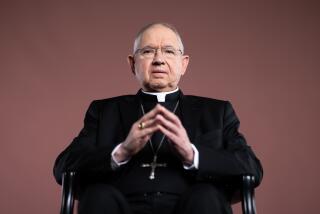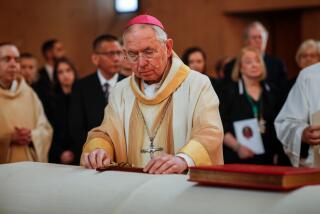Jenco Asks Prayers for Hostages
- Share via
--Father Lawrence Martin Jenco, the Roman Catholic priest who spent 19 months in captivity in Beirut, used his farewell sermon to worshipers in Portland, Ore., to exhort them to remember the remaining U.S. and British hostages. “I hope after I leave, you will not forget them in your prayers,” Jenco said at the Mass at The Grotto, a shrine to the Servite order where he had been living since February. “May we one day meet again in the kingdom of God, where there is only Jesus and dancing.” Jenco, who was released from captivity in July of 1986, also called on the worshipers to maintain a “childlike capacity to trust” and to use children as a model in treatment of their fellow man. “Children don’t choose friends on the color of their skin, their clothes or the size of their house,” he said. Jenco arrived Monday in Los Angeles, where he will be a Roman Catholic chaplain at USC.
--It wasn’t that the English were so swift, it was that the Spanish guns were so clumsy, says a military historian challenging the traditional reason for the Armada’s loss to the English navy in the decisive battle of 1588. History buffs have long contended that Sir Francis Drake outmaneuvered the Spanish Armada with England’s swift ships, thus ending a planned invasion and occupation of England, in what has been described as the worst naval thrashing in Spanish history. But Geoffrey Parker contends in an article in the inaugural issue of MHQ, The Quarterly Journal of Military History, that the Spanish lost the battle because of their inability to load their guns more than twice a day. Parker is a Charles E. Novell Distinguished Professor of History at the University of Illinois.
--When Pennsylvania officials decided to replace a 60-year-old bridge near Meadville, they balked at building a temporary bridge, figuring it would take two weeks to build and cost at least $50,000. But residents using donated materials built their own bridge--in two days and at a cost of $7,722. The residents, many of them Amish and Mennonite farmers who use horse-drawn buggies, wanted to avoid having to use a 4.5-mile detour along bumpy roads that the state had proposed in place of the temporary bridge. “Didn’t cost the state a thing,” said Harold Graves, who helped organize the building of the bridge. “We saved them money, and we saved everyone around here a lot of money and inconvenience.” The homemade bridge also had no trouble meeting state building standards, passing an inspection with flying colors.
More to Read
Sign up for Essential California
The most important California stories and recommendations in your inbox every morning.
You may occasionally receive promotional content from the Los Angeles Times.










